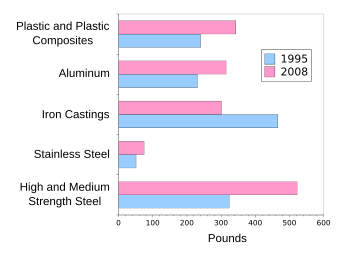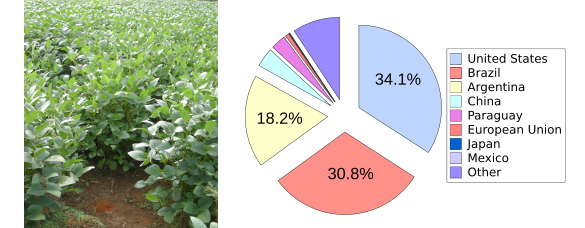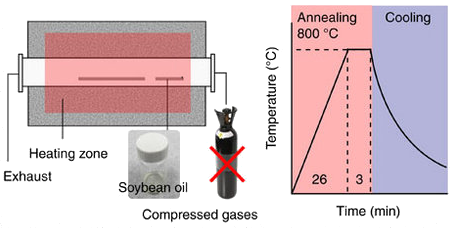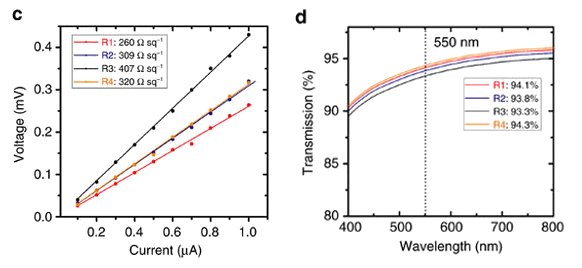Soybean Graphene
March 23, 2017
One memorable scene from the 1967
film, "
The Graduate" (
Mike Nichols,
Director),[1] has a
neighbor mentoring the recent
college graduate on a
career choice.[2]
Mr. McGuire: I just want to say one word to you. Just one word.
Benjamin: Yes, sir.
Mr. McGuire: Are you listening?
Benjamin: Yes, I am.
Mr. McGuire: Plastics.
As I survey my home, I see that this was good advice. The
wooden toys of my
youth were replaced by plastic versions for my
children and
grandchildren, and most of the
high-tech items such as
computer monitors,
televisions, and
cellphones are encased in plastic. The
automotive industry has always been a
materials innovator; and, as the
chart shows, the plastic content of
light vehicles has increased while the
weight of
cast iron pieces has declined, principally as a
fuel economy strategy.

Light vehicle material weights, 1995 and 2008.
Not shown are other materials, such as copper, brass, glass, textiles, fluids, etc., 2,382/2,513 pounds in 1995/2008.
(Graphed using Gnumeric from data in ref. 3.[3]
Two factors presently affect the viability of plastic materials in many applications. One is
sustainability, since most plastics are derived from
petroleum, about 4% of petroleum is used as plastic
feedstock, with an additional 4% used as
energy for plastic
manufacture.[4] The other is
plastic pollution. Although
Tikalon's Northern New Jersey township has a very active
recycling program, less than half of plastic is recycled worldwide.[4] The
United States is a most egregious
polluter, since only 9% of its
post-consumer plastic was recycled in 2012, with 32 million
tons being discarded.[4]
Plastic
degrades very slowly in the
environment, and this poses many problems for
humans and other
organisms. More than 250,000 tons of plastic particles are estimated to be floating in the
oceans.[4] One way to handle this problem is to make
plastic biodegradable, often through combination with
starch.
Protein derived from the
soybean (Glycine max) can be used to make protein
polymers that are not only biodegradable, but also
biorenewable.
The history of using soy as a material goes back quite a few years. A "
Soybean Car" was built by
Ford and exhibited in 1941. They say that "
necessity is the mother of invention," and the soybean car was developed in anticipation of the
rationing of
steel during
World War II. Only the body contained soy, along with other
agricultural materials, and it was about a quarter of an
inch thick. There was no further
development of this automobile concept after that, but it's interesting to speculate how the
history of the automobile, and agriculture, would have progressed if Ford had continued development.

Ford's 1941 "Soybean Car."
(Still image from a YouTube video by Aleksei Germanovich.)
Soy is a
species of
legume that's native to
East Asia, but the United States is a major soybean producer (see chart). Soybeans are an
oilseed, rather than a
pulse. Soy, which is 38-45% protein and nearly 20%
oil, yields a high quantity of protein per
acre. Soy is used as a protein source in
animal feeds and the
tofu that I enjoy in several
recipes. Soy is used as a
milk substitute (I prefer
almond milk), as a
vegetable oil, and is
fermented to produce
soy sauce.

Left, a soy field; right, estimated 2016 soy production. Soy is third only to wheat and corn as a US agricultural export. (Left, a Wikimedia commons image by Harry and Carol Rose; right, a pie chart of U.S. Department of Agriculture data using Gnumeric.[5]
Since soy is a renewable resource that's successfully used as a
structural material, it would be worthwhile investigating whether it might be used as a starting material for other purposes. That's the idea pursued by
Australian scientists from
CSIRO Manufacturing (Lindfield, New South Wales, Australia), the
University of Sydney (Sydney, Australia), the
University of Technology (Sydney, Australia), and
Queensland University of Technology (Brisbane, Australia).[6-8] This
research team has developed a single-step process that they call
GraphAir for making uniform and continuous
graphene films in
ambient-air using soybean oil as the
precursor.[6,8] As they write in their
paper describing this process, this is the first time that graphene
synthesis has been accomplished in an ambient-air environment without any
compressed gases.[6]
Graphene is typically grown using
chemical vapor deposition techniques that require a 1,000
°C temperature,
purified gases, such as
methane,
hydrogen, and
argon, and a
vacuum chamber.[6] The novel process uses an ambient-air environment and soybean oil to produce graphene films with
properties comparable to graphene synthesized using other methods.[6]
As shown in the figure, a
polycrystalline nickel foil of 25
micrometers thickness and 99.5 % purity, used as the
growth substrate, is contained in a sealed
quartz glass tube, 100 cm in length and 5 cm in
diameter. An
alumina plate coated with 0.14 ml of soybean oil is also contained in the quartz glass tube, and the tube is thermally cycled as shown by increasing the
furnace temperature to 800 °C at a rate of 30 °C/min, holding at 800 °C for three minutes, then sliding the foil section out of the furnace for
quenching at a rapid rate.[6]

Soybean graphene process. Graphene films are grown on polycrystalline nickel foils that are thermally annealed together with a soybean oil precursor. These graphene films are then transferred onto glass substrates. (Portion of fig.1 of ref. 6, licensed under the Creative Commons Attribution 4.0 International License.)
Transfer of the graphene was accomplished by
spin coating the layer with
poly(methyl methacrylate), PMMA, drying in air for twelve hours, and
etching away the nickel foil in a
ferric chloride solution. The PMMA with attached graphene, which was floating atop the ferric chloride etchant, was rinsed with
deionized water and transferred to a
glass slide where the PMMA was removed with
acetone.[6] The properties of such graphene layers are shown below.[6]

Properties of soybean graphene, as grown on polycrystalline nickel foil and transferred onto glass. Shown are four-point resistance and optical transmittance. (Portion of fig.3 of ref. 6, licensed under the Creative Commons Attribution 4.0 International License.)
Says
CSIRO scientist and
co-author of the paper describing this research,
Zhaojun Han, "This ambient-air process for graphene fabrication is fast, simple, safe, potentially scalable, and integration-friendly."[8] The team has even made graphene from
waste oils.[8]
References:
- The Graduate, 1967, Mike Nichols, Director, on the Internet Movie Database.
- The Graduate "One Word: Plastics," YouTube Video by Lance Ehlers, November 9, 2007.
- Material Content per Light Vehicle, 1995 and 2008, Fact Sheet #642, Office of Energy Efficiency & Renewable Energy, US Department of Energy, September 27, 2010.
- Global Plastic Production Rises, Recycling Lags, New Worldwatch Institute Press Release, January 28, 2015.
- World Agricultural Supply and Demand Estimates (WASDE - 562), U.S. Department of Agriculture, February 9, 2017 (PDF File).
- Dong Han Seo, Shafique Pineda, Jinghua Fang, Yesim Gozukara, Samuel Yick, Avi Bendavid, Simon Kwai Hung Lam, Adrian T. Murdock, Anthony B. Murphy, Zhao Jun Han, and Kostya (Ken) Ostrikov, "Single-step ambient-air synthesis of graphene from renewable precursors as electrochemical genosensor," Nature Communications, vol. 8, Article No. 14217 (January 30, 2017), doi:10.1038/ncomms14217. This is an open access article with a PDF file, here.
- Supplementary Information for ref. 6.
- CSIRO makes high-quality graphene with soybeans, Commonwealth Scientific and Industrial Research Organisation (CSIRO) Press Release, January 31, 2017.
Permanent Link to this article
Linked Keywords: Film; The Graduate; Mike Nichols; Director; neighbor; mentor; mentoring; college graduate; career; plastics; wooden toys; youth; child; children; grandchildren; high-tech; computer monitor; relevision set; mobile phone; cellphone; automotive industry; materials; innovation; innovator; chart; automobile; light vehicle; weight; cast iron; fuel economy; copper; brass; glass; textile; fluid; Gnumeric; sustainability; petroleum; raw material; feedstock; energy; manufacturing; manufacture; plastic pollution; Tikalon; Roxbury Township, New Jersey; Northern New Jersey township; recycling; United States; pollution; polluter; post-consumer waste; ton; chemical decomposition; degrade; environment; human; organism; ocean; biodegradable plastic; starch; protein; soybean (Glycine max); polymer; renewable resource; biorenewable; Soybean Car; Ford Motor Company; necessity is the mother of invention; rationing; steel; World War II; agriculture; agricultural; inch; research and development; history; YouTube video; species; legume; East Asia; oilseed; pulse; oil; acre; animal feed; tofu; recipe; milk substitute; almond milk; vegetable oil; fermentation; fermented; soy sauce; wheat; corn; export; Wikimedia commons; pie chart; United States Department of Agriculture; data; structural material; Australia; Australian; scientist; CSIRO Manufacturing (Lindfield, New South Wales, Australia); University of Sydney (Sydney, Australia); University of Technology (Sydney, Australia); Queensland University of Technology (Brisbane, Australia); research; graphene; ambient-air; precursor; scientific literature; paper; chemical synthesis; gas cylinder; compressed gas; chemical vapor deposition; celsius; °C; temperature; purification; purified; methane; hydrogen; argon; vacuum chamber; materials properties; crystallite; polycrystalline; nickel; micrometer; crystal growth; growth; fused quartz; quartz glass; diameter; aluminium oxide; alumina; furnace; quenching; quench; thermally annealed; glass; Creative Commons Attribution 4.0 International License; spin coating; poly(methyl methacrylate); etching; iron(III) chloride; ferric chloride; aqueous solution; purified water; deionized water; microscope slide; glass slide; acetone; four-terminal sensing; four-point sensing; resistance; optics; optical; transmittance; Commonwealth Scientific and Industrial Research Organisation; CSIRO; author; Zhaojun Han; waste oils.